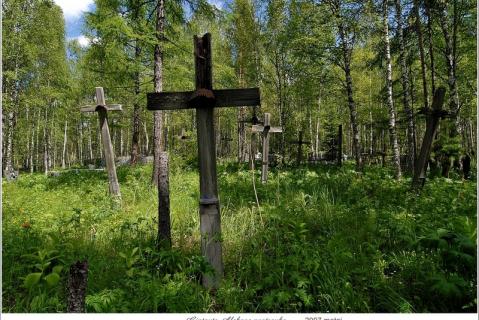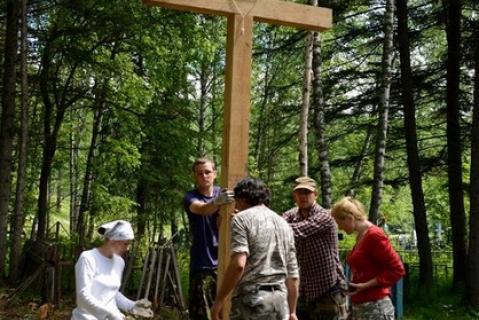In June 1948 about 250 Lithuanian men, women and children were deported to the Khabaidak special settlement where they became the majority of the inhabitants. The deportees worked felling timber, building roads and houses. Those who died were buried in the local cemetery, alongside Khabaidak residents of other nationalities. After 1956, when the special settlement restrictions were lifted, the Lithuanians began to return home.
In 1970, 1982 and again in 1989-1990, relatives of those who died in Khabaidak returned there in order to gather the remains of their loved ones for reburial in Lithuania. In 2013, the “Siberian Mission” Lithuanian youth expedition (director, G. Alekna) visited Khabaidak and found 20 crosses on graves with Lithuanian inscriptions, some of which were still legible. The expedition members cleared up the graveyard, raised the fallen crosses and erected a tall commemorative cross there.
Research on the Genocide of the Lithuanian People (Lietuvos gyventoju Genocidas; 3 vols. 1999-2009) contains about 130,000 biographical entries (in Lithuanian). Volume 3 covers the period from 1948 onwards and see Deportation of Lithuanians, 1941-1951 for the 28 other burial grounds and commemorative sites on the Map of Memory.
The Memorial online database (2025) includes 55,742 victims in the Krasnoyarsk Krai (Region). See Yeniseisk.
Drawing on other sources the database lists more than 12,000 sent to the the Krasnoyarsk Region, some to its camps (1,017), most to its special settlements (11,000), but does not include Lithuanian deportees.
| State of burials | Area | Boundaries |
|---|---|---|
|
About twenty headboards have survived
|
not established
|
partially delineated
|
[ Original texts & hyperlinks ]
A. Juodvalkytė, “Chabaidakas” Universal Lithuanian Encyclopaedia, Vol 3, Vilnius, 2003 (in Lithuanian)
Tomas Janonis, “Of all deportees the Lithuanians were the most open and they liked Russians”, Delfi news website, 31 July 2013 [retrieved, 30 May 2022]
“Lithuanian deportation to the Krasnoyarsk Krai” [Lietuvos tremtiniai Krasnojarsko krašte], National Museum of Lithuania (in Lithuanian) [retrieved, 30 May 2022]


